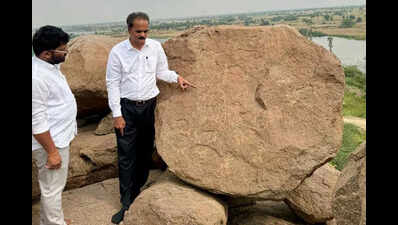- News
- Rock art dating back to Neolithic period discovered in Nalgonda
Rock art dating back to Neolithic period discovered in Nalgonda
Hyderabad: An archaeologist found rock bruisings from the prehistoric period on a hillock located on the outskirts of Ramalingalagudem village in Nalgonda district. During a survey of the area, archaeologist Dr E Sivanagi Reddy identified engravings of bulls, stags, dogs, human figures, and a striking depiction of a man fighting a tiger.
These figures, dated to the Neolithic period (6000–4000 BCE), were created using stone tools through repeated striking.
Dr Reddy noted that the engravings reflect the lifestyle of prehistoric humans, especially their hunting practices and an inherent drive to express their interactions with nature.
He also discovered rock shelters likely used as temporary campsites, along with grooves in front of them—evidence of stone axes being sharpened. At the end of his exploration, Dr Reddy sensitised the local villagers about the need to preserve rock art, emphasising its archaeological significance. Artist Silpi Venkatesh also participated.
Executed by using natural and vegetable colours mixed with tree slime and animal fats, the paintings were drawn on outcrops, walls, and ceilings of rock shelters and caves. The imagery includes men, women, animals, birds, and aquatic life, depicted in both stick (linear) and full-body forms.
The bruisings at Ramalingalagudem, like those at other sites, were made by striking rock surfaces with stone tools. Sites like Pandavula Gutta even exhibit x-ray-style paintings showing skeletal and internal features. The most common colours used in these artworks include red, yellow, and white.

About the Author
U Sudhakar ReddyEnd of Article
Follow Us On Social Media







